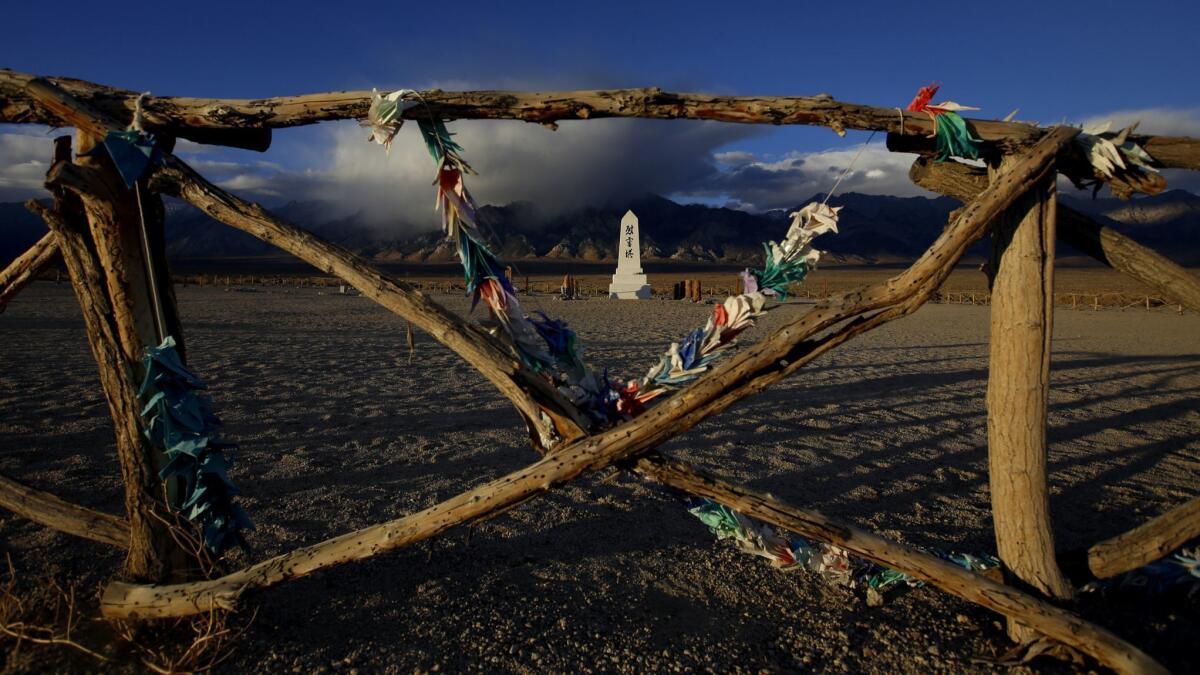Op-Ed: We frame California’s history as romantic more than xenophobic. We need to feel the shame

Late last month, I took a road trip from Los Angeles to Manzanar. The World War II era concentration camp, which interned more than 10,000 Japanese Americans between 1942 and 1945, sits just 220 miles north of us, in a windswept section of the Owens River Valley — and yet, in all the years that I have lived in Southern California, I had never visited it before.
I drove up on a Saturday: the 405 to the 5 to the 14 to 395. I passed through the town of Lone Pine, and 7 miles further north, there it was. The site is marked by a pair of entrances: The first to the old camp itself, and the second to a parking lot and museum site. The museum features exhibits in a building originally constructed as an auditorium for internees. There are a handful of barracks, a dining hall and not much else.
This there-but-not-all-there piece of history is how we too often reckon with the past in California. Even when we preserve it, even when we confront it, we also paradoxically erase it, distancing ourselves. We prettify the past with “Spanish” tile and bell towers. We frame the missions and their legacy as romantic rather than virulent.
Manzanar was one of 10 American concentration camps, some as far east as Arkansas, in which 110,000 Japanese Americans were interned.
Certainly, California’s culture of transplants has played a part in this. As the poet William Everson wrote in the 1950s, even California’s “graveyards have been built within living memory.” Everson was engaging in a bit of literary hyperbole — the state’s formal burial grounds date to the 1700s — but he isn’t far off about our ahistorical tendencies.
Manzanar represents a case-in-point. The camp was almost entirely dismantled not long after World War II ended, and only became a California landmark in 1972. For 30 years, we mostly preferred to ignore what happened there. It wasn’t until 1988 that the federal government offered compensation to surviving internees.
“Here we admit a wrong,” President Reagan acknowledged at the time. “Here we reaffirm our commitment as a nation to equal justice under the law.”
Now administered by the National Park Service, Manzanar was one of 10 American concentration camps, some as far east as Arkansas, in which 110,000 Japanese Americans were interned. “[T]hat unlikely place of wind, sand and heat,” the California writer Hisaye Yamamoto recalled in her 1950 short story “The Legend of Miss Sasagawara,” and if the camp she was describing was the one in Poston, Ariz. — to which she was sent with her family — the description applies equally to Manzanar.
In the shadow of Mt. Whitney, the site is severe and windswept, subject to extremes of summer heat and winter cold. It is now so empty that even to imagine 10,000 people concentrated at the site is a stretch. To be there is to get a sense of the space required for the camp, but only the merest idea of what it was like to be interned.
In one barracks, I walked through restored living quarters with straw-filled mattresses and furniture made from citrus crates; in another, I found a reconstructed classroom. It is not possible to stand in such a place without thinking of the countless tragedies and humiliations set in motion by internment, or of the new outrages unspooling on our southern border now. And yet, the effect is less that of revisiting our past, our history — or remembering our present — than of a kind of redeveloped movie set.
Manzanar may not have been romanticized, like the missions and ranchos and the Californios, but it has been sanitized. Eight guard towers once dotted the perimeter, in view of Highway 395. The originals are all gone, but in 2005, one was rebuilt; it now stands like a sentry or a symbol next to a barbed-wire fence along the eastern edge of the road.
Enter the Fray: First takes on the news of the minute from L.A. Times Opinion »
The tower, too, fits the paradox of history in California. Think about Chinatown in Los Angeles, torn down to make way for Union Station, then resurrected in a new location, as if no community had ever been disrupted and displaced. Think about the Zoot Suit Riots and the way we rarely speak of them. They, like the order that created Manzanar, grew out of a deep history of racial discrimination and stereotypes.
Manzanar stands as a monument to those interned there, but it should also be a clear reminder of American xenophobia, the divisions we have never put away. It is, however, so clean, so stripped down, that it feels as if this history isn’t one we need to claim or worry about. “When my mother got into the room,” an internee named Sue Kunitomi Embry recalled (her words are part of the exhibit), “she sat down on one of the mattresses and she said, ‘My, what a place,’ and she never talked about that for many, many years afterwards.”
I think what Embry is referring to is her mother’s feeling of shame, although that shame is ours, not hers. This is our legacy, our history, and we have never needed to talk about it, facing it squarely and feeling it viscerally, more than we do now.
David L. Ulin is a contributing writer to Opinion.
Follow the Opinion section on Twitter @latimesopinionand Facebook
More to Read
A cure for the common opinion
Get thought-provoking perspectives with our weekly newsletter.
You may occasionally receive promotional content from the Los Angeles Times.











